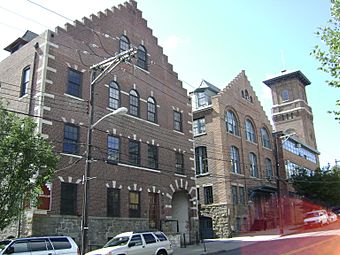Knickerbocker Building (New Rochelle, New York) facts for kids
Quick facts for kids |
|
|
Knickerbocker Press Building
|
|
 |
|
| Location | 50-52 Webster Ave., New Rochelle, New York |
|---|---|
| Built | 1889 |
| Architectural style | Dutch Colonial Revival |
| NRHP reference No. | 00000487 |
| Added to NRHP | May 11, 2000 |
The Knickerbocker Press Building is a cool old building with a special style called Dutch Colonial Revival. You can find it at 50-52 Webster Avenue in New Rochelle, a city in Westchester County, New York. It was built a long time ago, in 1889.
What the Building Looks Like
The Knickerbocker Press Building is actually a group of big brick buildings connected together. It has unique stepped roofs, called gables, which look like buildings from the Dutch or Flemish style. There's also a tall, square tower that is four stories high.
The building has three main parts. The biggest part faces the street, and two smaller parts are attached to its east side. With its special stepped gables, arched windows, and cool brick designs, this building is a rare example of the Flemish Renaissance Revival style.
A three-story brick section was added in the 1930s. This part has a more modern, simple style with large steel windows. But most of the outside of the building still looks like it did when it was first built. You can still see colorful designs made with bricks around the windows and doors. There are also brick walls that go all the way to the railroad tracks, forming the supports for the nearby Webster Avenue Bridge. If you look up, you can still see the words "The Knickerbocker Press" on the roof!
History of the Knickerbocker Press Building
The Knickerbocker Press Building was built in 1889 by a company called G.P. Putnam and Sons. They were a very important book publisher back then. The word "Knickerbocker" often refers to someone from New York, named after the first Dutch settlers there.
The company loved the books of a famous writer named Washington Irving. G.P. Putnam had originally published his books, including his well-known "Knickerbocker's History of New York." Irving was a big fan of Dutch-style buildings, which you can see in his writings and even at his own home, Sunnyside, in Tarrytown, New York. It's thought that the Knickerbocker Press building got its name from this connection to Irving and the Dutch heritage.
Records show that the Knickerbocker Press owned the building until 1934. After that, for about 30 years, a company called American White Cross Laboratories used the building. They made medical supplies like bandages and cotton balls. In the 1980s and 1990s, some parts of the building were used as art studios by different artists. Then, in 2007, the building was changed into apartments for people to live in.
Because of its unique history and architecture, the Knickerbocker Press Building was added to the lists of historic places for Westchester County, New York State, and the whole country in the year 2000.




